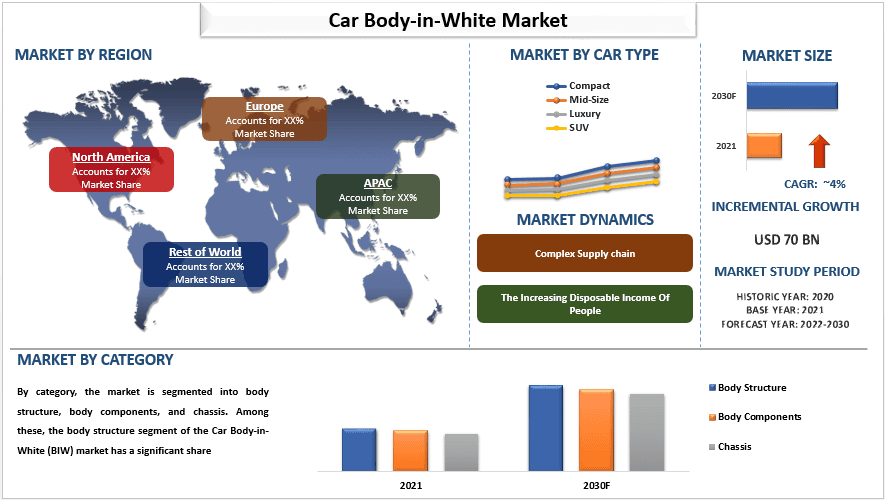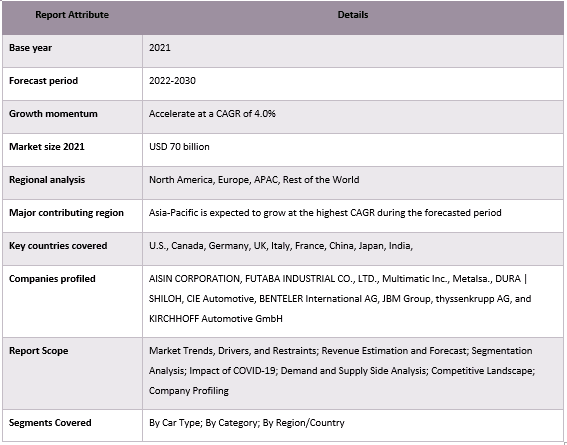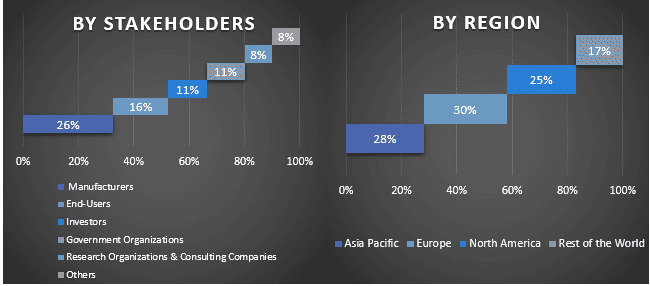- Home
- About Us
- Industry
- Services
- Reading
- Contact Us
Car Body-in-White Market: Current Analysis and Forecast (2022-2030)
Emphasis on Car Type (Compact, Mid-Size, Luxury, and SUV); Category (Body Structure, Body Components, and Chassis); Region/Country.

Car Body-in-White Market was valued at USD 70 billion in 2021 & is expected to grow at a CAGR of 4% from 2022-2030. One of the main drivers of the BIW market is the increasing demand for lightweight and fuel-efficient cars. As consumers become more environmentally conscious, there is a growing demand for cars that are more fuel-efficient and have lower carbon emissions. This has led to the development of advanced materials and manufacturing techniques to produce BIW, which can help to reduce the weight of cars and improve their fuel efficiency. Another driver of the BIW market is the growing popularity of electric vehicles (EVs). EVs have different body structures compared to traditional internal combustion engine (ICE) cars, and manufacturers are investing heavily in the development of new and innovative body structures that can meet the specific requirements of EVs. This has led to an increase in demand for BIW products that are specifically designed for EVs.
In addition, the global BIW market is also driven by the increasing focus on vehicle safety. Car manufacturers are under pressure to ensure that their vehicles meet certain safety standards, which has led to an increased focus on the production of high-quality BIW products that can withstand crashes and provide adequate protection to the occupants.
Some of the major players operating in the market AISIN CORPORATION, FUTABA INDUSTRIAL CO., LTD., Multimatic Inc., Metalsa., DURA | SHILOH, CIE Automotive , BENTELER International AG, JBM Group, thyssenkrupp AG, and KIRCHHOFF Automotive GmbH. Several M&As along with partnerships have been undertaken by these players to facilitate customers with hi-tech and innovative products/technologies.
Insights Presented in the Report
“Amongst car type, the luxury segment of the market has significant growth.”
Based on car types, the market is segmented into compact, mid-size, luxury, and SUVs. Amongst these, the luxury segment of the Car Body-in-White (BIW) market has significant growth due to several factors. Firstly, the luxury segment is characterized by a high level of disposable income among consumers, which allows them to purchase high-end cars that are equipped with advanced technologies and features. This has led to an increase in demand for BIW products that can meet the specific requirements of high-end cars, such as advanced materials and manufacturing techniques. Secondly, the Luxury segment is highly influenced by trends and consumer preferences, which are constantly evolving. Car manufacturers in the Luxury segment are under pressure to stay ahead of these trends and preferences by introducing new and innovative designs and features that can differentiate their products from those of their competitors.
“Amongst Category, the chassis segment of the market has significant growth.”
By category, the market is segmented into body structure, body components, and chassis. Among these, the chassis segment of the Car Body-in-White (BIW) market has significant growth due to several factors. Firstly, car manufacturers are investing heavily in the development of advanced chassis technologies that can provide better handling, stability, and safety to their cars. This has led to an increased demand for BIW products that can be used to manufacture high-performance and safety-enhanced chassis. Secondly, the chassis segment of the BIW market is also growing due to the increasing adoption of electric vehicles (EVs). EVs have different chassis requirements compared to traditional internal combustion engine (ICE) cars, and manufacturers are investing heavily in the development of new and innovative chassis technologies that can meet the specific requirements of EVs.
“Asia-Pacific is expected to grow at the highest CAGR during the forecasted period.”
Several factors that could contribute to the growth of the Asia-Pacific region in this market. Firstly, the automotive industry in Asia-Pacific is experiencing rapid growth due to increasing consumer demand, government initiatives, and foreign investments. This growth is expected to continue in the forecasted period, driving the demand for car body-in-white products in the region. Secondly, advancements in technology and production processes are contributing to the growth of the car body-in-white market in Asia-Pacific. Automakers in the region are investing in advanced technologies such as lightweight materials, advanced manufacturing processes, and recycling techniques to produce more efficient and cost-effective car body-in-white products. Lastly, the presence of a large number of car manufacturers and suppliers in the Asia-Pacific region is also driving the growth of the car body-in-white market. These companies are investing in research and development, production facilities, and supply chain management to meet the increasing demand for car body-in-white products. Overall, the growth of the Asia-Pacific region in the car body-in-white market is likely to be driven by a combination of factors, including increasing consumer demand, advancements in technology and production processes, and the presence of a large number of car manufacturers and suppliers in the region.
Car Body-in-White Market Report Coverage

Reasons to buy this report:
- The study includes market sizing and forecasting analysis validated by authenticated key industry experts.
- The report presents a quick review of overall industry performance at one glance.
- The report covers an in-depth analysis of prominent industry peers with a primary focus on key business financials, product portfolios, expansion strategies, and recent developments.
- Detailed examination of drivers, restraints, key trends, and opportunities prevailing in the industry.
- The study comprehensively covers the market across different segments.
- Deep dive regional level analysis of the industry.
Customization Options:
The global car body-in-white market can further be customized as per the requirement or any other market segment. Besides this, UMI understands that you may have your own business needs, hence feel free to contact us to get a report that completely suits your requirements.
Table of Content
Research Methodology for the Car Body-in-White Market Analysis (2022-2030)
Analyzing the historical market, estimating the current market, and forecasting the future market of the global car body-in-white market were the three major steps undertaken to create and analyze the adoption of car body-in-white in major regions globally. Exhaustive secondary research was conducted to collect the historical market numbers and estimate the current market size. Secondly, to validate these insights, numerous findings and assumptions were taken into consideration. Moreover, exhaustive primary interviews were also conducted, with industry experts across the value chain of the global car body-in-white market. Post assumption and validation of market numbers through primary interviews, we employed a top-down/bottom-up approach to forecasting the complete market size. Thereafter, market breakdown and data triangulation methods were adopted to estimate and analyze the market size of segments and sub-segments of the industry pertains to. Detailed methodology is explained below:
Analysis of Historical Market Size
Step 1: In-Depth Study of Secondary Sources:
Detail secondary study was conducted to obtain the historical market size of the car body-in-white market through company internal sources such as annual reports & financial statements, performance presentations, press releases, etc., and external sources including journals, news & articles, government publications, competitor publications, sector reports, third-party database, and other credible publications.
Step 2: Market Segmentation:
After obtaining the historical market size of the car body-in-white market, we conducted a detailed secondary analysis to gather historical market insights and share for different segments & sub-segments for major regions. Major segments are included in the report as car type and category. Further country-level analyses were conducted to evaluate the overall adoption of testing models in that region.
Step 3: Factor Analysis:
After acquiring the historical market size of different segments and sub-segments, we conducted a detailed factor analysis to estimate the current market size of the car body-in-white market. Further, we conducted factor analysis using dependent and independent variables such as car type and category of the car body-in-white market. A thorough analysis was conducted for demand and supply-side scenarios considering top partnerships, mergers and acquisitions, business expansion, and product launches in the car body-in-white market sector across the globe.
Current Market Size Estimate & Forecast
Current Market Sizing: Based on actionable insights from the above 3 steps, we arrived at the current market size, key players in the global car body-in-white market, and market shares of the segments. All the required percentage shares split, and market breakdowns were determined using the above-mentioned secondary approach and were verified through primary interviews.
Estimation & Forecasting: For market estimation and forecast, weights were assigned to different factors including drivers & trends, restraints, and opportunities available for the stakeholders. After analyzing these factors, relevant forecasting techniques i.e., the top-down/bottom-up approach were applied to arrive at the market forecast for 2030 for different segments and sub-segments across the major markets globally. The research methodology adopted to estimate the market size encompasses:
- The industry’s market size, in terms of revenue (USD) and the adoption rate of the car body-in-white market across the major markets domestically
- All percentage shares, splits, and breakdowns of market segments and sub-segments
- Key players in the global car body-in-white market in terms of products offered. Also, the growth strategies adopted by these players to compete in the fast-growing market.
Market Size and Share Validation
Primary Research: In-depth interviews were conducted with the Key Opinion Leaders (KOLs) including Top Level Executives (CXO/VPs, Sales Head, Marketing Head, Operational Head, Regional Head, Country Head, etc.) across major regions. Primary research findings were then summarized, and statistical analysis was performed to prove the stated hypothesis. Inputs from primary research were consolidated with secondary findings, hence turning information into actionable insights.
Split of Primary Participants in Different Regions

Market Engineering
The data triangulation technique was employed to complete the overall market estimation and to arrive at precise statistical numbers for each segment and sub-segment of the global car body-in-white market. data was split into several segments & sub-segments post studying various parameters and trends in the areas of the car type and category in the global car body-in-white market.
The main objective of the Global Car Body-in-White Market Study
The current & future market trends of the global car body-in-white market were pinpointed in the study. Investors can gain strategic insights to base their discretion for investments on the qualitative and quantitative analysis performed in the study. Current and future market trends determined the overall attractiveness of the market at a regional level, providing a platform for the industrial participant to exploit the untapped market to benefit from a first-mover advantage. Other quantitative goals of the studies include:
- Analyze the current and forecast market size of the car body-in-white market in terms of value (USD). Also, analyze the current and forecast market size of different segments and sub-segments.
- Segments in the study include areas of the car type and category.
- Define and analysis of the regulatory framework for the car body-in-white
- Analyze the value chain involved with the presence of various intermediaries, along with analyzing customer and competitor behaviors of the industry.
- Analyze the current and forecast market size of the car body-in-white market for the major region.
- Major countries of regions studied in the report include Asia Pacific, Europe, North America, and the Rest of the World
- Company profiles of the car body-in-white market and the growth strategies adopted by the market players to sustain in the fast-growing market.
- Deep dive regional level analysis of the industry
Related Reports
Customers who bought this item also bought










